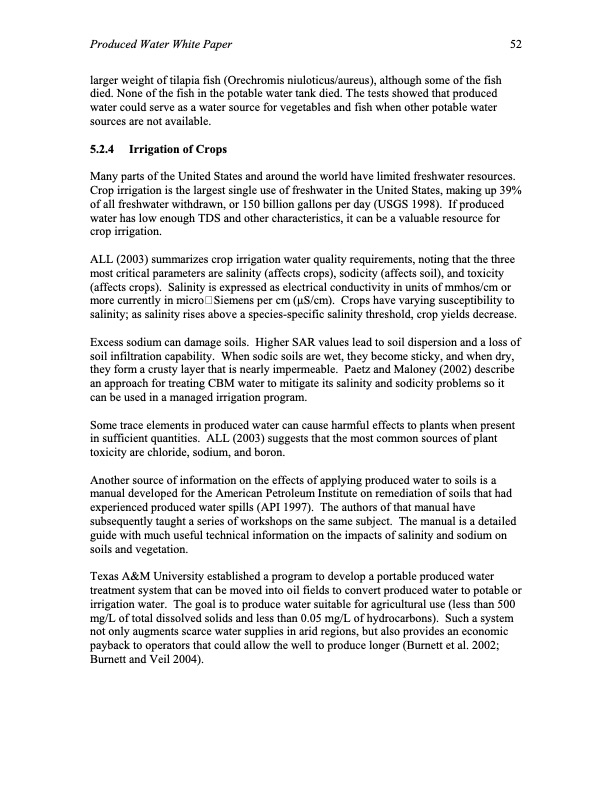
PDF Publication Title:
Text from PDF Page: 060
Produced Water White Paper 52 larger weight of tilapia fish (Orechromis niuloticus/aureus), although some of the fish died. None of the fish in the potable water tank died. The tests showed that produced water could serve as a water source for vegetables and fish when other potable water sources are not available. 5.2.4 Irrigation of Crops Many parts of the United States and around the world have limited freshwater resources. Crop irrigation is the largest single use of freshwater in the United States, making up 39% of all freshwater withdrawn, or 150 billion gallons per day (USGS 1998). If produced water has low enough TDS and other characteristics, it can be a valuable resource for crop irrigation. ALL (2003) summarizes crop irrigation water quality requirements, noting that the three most critical parameters are salinity (affects crops), sodicity (affects soil), and toxicity (affects crops). Salinity is expressed as electrical conductivity in units of mmhos/cm or more currently in micro�Siemens per cm (μS/cm). Crops have varying susceptibility to salinity; as salinity rises above a species-specific salinity threshold, crop yields decrease. Excess sodium can damage soils. Higher SAR values lead to soil dispersion and a loss of soil infiltration capability. When sodic soils are wet, they become sticky, and when dry, they form a crusty layer that is nearly impermeable. Paetz and Maloney (2002) describe an approach for treating CBM water to mitigate its salinity and sodicity problems so it can be used in a managed irrigation program. Some trace elements in produced water can cause harmful effects to plants when present in sufficient quantities. ALL (2003) suggests that the most common sources of plant toxicity are chloride, sodium, and boron. Another source of information on the effects of applying produced water to soils is a manual developed for the American Petroleum Institute on remediation of soils that had experienced produced water spills (API 1997). The authors of that manual have subsequently taught a series of workshops on the same subject. The manual is a detailed guide with much useful technical information on the impacts of salinity and sodium on soils and vegetation. Texas A&M University established a program to develop a portable produced water treatment system that can be moved into oil fields to convert produced water to potable or irrigation water. The goal is to produce water suitable for agricultural use (less than 500 mg/L of total dissolved solids and less than 0.05 mg/L of hydrocarbons). Such a system not only augments scarce water supplies in arid regions, but also provides an economic payback to operators that could allow the well to produce longer (Burnett et al. 2002; Burnett and Veil 2004).PDF Image | Produced Water from Production of Crude Oil

PDF Search Title:
Produced Water from Production of Crude OilOriginal File Name Searched:
ProducedWatersWP0401.pdfDIY PDF Search: Google It | Yahoo | Bing
NFT (Non Fungible Token): Buy our tech, design, development or system NFT and become part of our tech NFT network... More Info
IT XR Project Redstone NFT Available for Sale: NFT for high tech turbine design with one part 3D printed counter-rotating energy turbine. Be part of the future with this NFT. Can be bought and sold but only one design NFT exists. Royalties go to the developer (Infinity) to keep enhancing design and applications... More Info
Infinity Turbine IT XR Project Redstone Design: NFT for sale... NFT for high tech turbine design with one part 3D printed counter-rotating energy turbine. Includes all rights to this turbine design, including license for Fluid Handling Block I and II for the turbine assembly and housing. The NFT includes the blueprints (cad/cam), revenue streams, and all future development of the IT XR Project Redstone... More Info
Infinity Turbine ROT Radial Outflow Turbine 24 Design and Worldwide Rights: NFT for sale... NFT for the ROT 24 energy turbine. Be part of the future with this NFT. This design can be bought and sold but only one design NFT exists. You may manufacture the unit, or get the revenues from its sale from Infinity Turbine. Royalties go to the developer (Infinity) to keep enhancing design and applications... More Info
Infinity Supercritical CO2 10 Liter Extractor Design and Worldwide Rights: The Infinity Supercritical 10L CO2 extractor is for botanical oil extraction, which is rich in terpenes and can produce shelf ready full spectrum oil. With over 5 years of development, this industry leader mature extractor machine has been sold since 2015 and is part of many profitable businesses. The process can also be used for electrowinning, e-waste recycling, and lithium battery recycling, gold mining electronic wastes, precious metals. CO2 can also be used in a reverse fuel cell with nafion to make a gas-to-liquids fuel, such as methanol, ethanol and butanol or ethylene. Supercritical CO2 has also been used for treating nafion to make it more effective catalyst. This NFT is for the purchase of worldwide rights which includes the design. More Info
NFT (Non Fungible Token): Buy our tech, design, development or system NFT and become part of our tech NFT network... More Info
Infinity Turbine Products: Special for this month, any plans are $10,000 for complete Cad/Cam blueprints. License is for one build. Try before you buy a production license. May pay by Bitcoin or other Crypto. Products Page... More Info
| CONTACT TEL: 608-238-6001 Email: greg@infinityturbine.com | RSS | AMP |